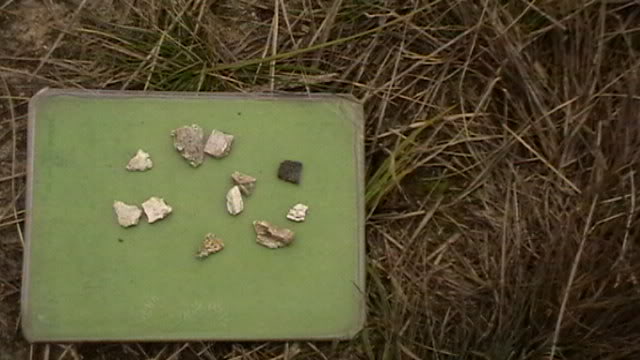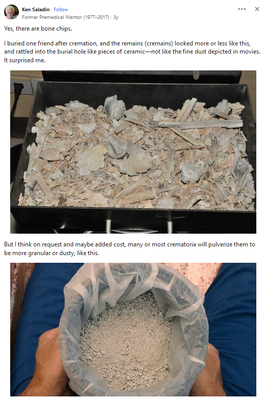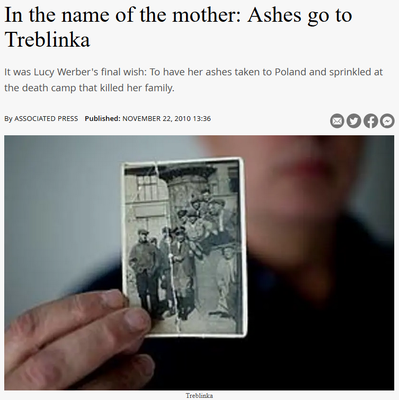bombsaway wrote:Not just human remains, but burnt bone fragments, which is evidence of cremation and body destruction. Such fragments being found on the surface of these sites 80 years after the events in question, yes is consistent with their description in orthodox literature. I think this photographic evidence fulfills one of your requests (for at least 1 mg of human remains)
What you're describing is that items which are relatively easy to obtain [from literally anyone's dead relative(s)] have shown up at surface level of 'Holocaust' sites to which many thousands of tourists visit each year. It's a site for which a particular narrative has powerful political incentives for those who maintain said narrative. Much like the nail-scratches in the Auschwitz 'chambers', there's no doubt that [Jewish?] tourists are willing to add their own "flair" to alleged 'extermination' sites to add dramatic effect and to maintain the narrative. Please don't make me also dig up the numerous examples of Jews caught lying about the Holohoax so people "wouldn't forget". It's the same motive for the same act: deception.
Here are what cremains look like when your grandma goes to the oven (cremation), in today's world:
But surely, Jews wouldn't ever fly allll the way out to the AR camps to sprinkle human cremains on the 'extermination' sites...
would they?Lol, yes they would:
All of these obvious problems with your assertion that a few scattered bone fragments = millions of dead Jews seems to suggest that, perhaps, you have not really thought this through.
bombsaway wrote:Kola's core samples undercut Mattogno's argument, not yours. Mattogno does not make your argument as far as I can tell, instead taking Kola's findings at face value. So far no one here has taken up Mattogno's position.
Or, perhaps you misunderstand Mattogno's argument, which certainly seems to be the case in your suggesting that Kola's samples "undercut" anything at all. Mattogno, referring to Belzec in "The Operation Reinhard Camps" (TORC; p. 208):
On the other hand, when
it became a transit camp according to the revisionist thesis, at least 441,000
Jews passed through it. There undoubtedly occurred both natural and non-
natural deaths among them, the order of magnitude of which is difficult to es-
tablish. If one assumes with Dieter Pohl a mortality of some 5%,238 the death
toll would already be over 22,600.
This fact completely invalidates the orthodox commentators’ interpretation,
as it shows that the presence of human remains in the soil of the former Bełżec
Camp is not at all irreconcilable with the revisionist thesis. In order to truly re-
fute this thesis, it would be necessary to show that corpses in the order of mag-
nitude of hundreds of thousands are or were buried in the camp grounds.
https://holocausthandbooks.com/index.php?page_id=28The amount of human remains do not remotely account for claims of the "Holocaust". Out of 236 samples, only six were "positive" for human remains. Among these (TORC, p. 206-7):
...Pit No. 1 reportedly contains a layer of human remains of
indeterminate thickness. The presence of human remains is not documented by
the soundings for Pit No. 4. For Pit No. 10, human remains are present only in
three out of the seven samples published by Kola; since he says nothing about
the remaining nine, we have to limit ourselves to the reported data. In Pit No.
28, human remains were found in one out of three samples.
Therefore, the only legitimate conclusion that can be drawn from the core
samples is that the above-mentioned pits contain only scattered human re-
mains.
You keep repeating things like "substantial amounts of cremains" but you do not quantify these statements nor cite your source(s). It's confusing and I'm beginning to think you're just talking out of your behind.
1) Which
specific core samples are you saying are
confirmed to have had cremains identified?
2) Approximately how many human beings does the total mass of cremains you are saying have been identified amount to?
3) What significance do you ascribe to cremains in these quantities?
bombsaway wrote:Given Mattogno and Graf (who funded Krege's study) give him no mention in further books, likely the scans indicated mass graves or Krege didn't know what he was doing.
I added
bold to your bullshit, above. The truth is, Krege simply wouldn't allow it to be published (ibid., ftn. 293):
Editor’s remark: Sturdy Colls’s remarks were probably aimed at a brief news article by Australian
engineer Richard Krege about his 1999 ground-penetrating-radar research at Treblinka as pub-
lished in a German-language revisionist magazine in 2000, which states (Krege, p. 63):
“The comparison of this [GPR] image with [GPR] images of areas where the soil is known to
be untouched and essentially free of disturbances shows that the radar images taken by the
Australians in the Treblinka Camp show an almost perfect soil untouched by man.”
However, Krege managed to scan only a small part of the former camp area. Due to a lack of
funding and time, he was unable to scan the rest of the camp. As a result, Krege refused to publish
his entire dataset, because he considered it highly incomplete and inconclusive. See Neumaier/
Rudolf, p. 505.





